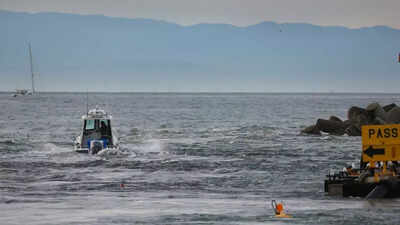ARTICLE AD BOX

After a massive magnitude 8.8 earthquake struck near Russia’s Kamchatka Peninsula, a tsunami advisory has been issued for the entire California coast. The US National Weather Service (NWS) has issued a tsunami watch for large parts of California’s coastline.
Experts forecast that waves could hit as early as 11:50 p.m. PDT on July 29, beginning in Fort Bragg and progressing south through better-known cities like San Francisco, Los Angeles, San Diego, and Oceanside.
Areas under Tsunami Watch (along with expected time of arrival)
Officials have released an estimated timeline for when waves could strike specific locations along the West Coast.Fort Bragg – 11:50 p.m. PDT (July 29)Crescent City – 11:55 p.m. PDTMonterey – 12:15 a.m. PDT (July 30)Port San Luis – 12:35 a.m. PDTSan Francisco – 12:40 a.m. PDTSanta Barbara – 12:50 a.m. PDTLos Angeles Harbor – 1:05 a.m. PDTNewport Beach – 1:10 a.m. PDTOceanside & La Jolla – 1:15 a.m. PDTLos Angeles proper, San Diego (Oceanside and La Jolla), and Bay Area coastal communities may experience wave activity between midnight and 1:15 a.m.
local time.
What is a tsunami warning?
A tsunami warning is the highest level of alert issued by Tsunami Warning Centers. It indicates that a tsunami with the potential to cause widespread flooding and dangerous currents is imminent, expected, or already occurring. Dangerous coastal flooding and powerful currents are expected and can continue for several hours after the initial wave arrives. Even seemingly small waves can generate destructive forces.
A tsunami advisory is issued when a tsunami with the potential to generate strong currents or dangerous waves in or very near the water is imminent, expected, or occurring.On the other hand, a tsunami watch is a type of tsunami message issued by tsunami warning centers to alert emergency management officials and the public that a tsunami may later impact a specific area. Tsunami watches are normally issued based on seismic information (like an earthquake occurring in a tsunamigenic zone) without confirmation that a destructive tsunami is already underway.
A tsunami watch may be upgraded to a tsunami advisory or warning, or it may be cancelled altogether, depending on updated information and analysis from the tsunami warning centers.
What to expect
This rare California tsunami advisory stems from a megathrust earthquake magnitude 8.8 off the Kamchatka Peninsula. Though California is thousands of miles from the epicenter, the geological reach of such powerful tremors can send energy across the Pacific within hours.So, what to expect?Wave heights in Los Angeles are expected to be less than one foot, with Port San Luis facing up to 3.2 feet and Santa Barbara between 0.9 and 1.7 feet. Even small waves can generate dangerous currents and strong surges, especially near harbors, beaches, and low-lying waterfronts. Experts warn that tsunamis often come in multiple waves, with the first wave not necessarily the largest, and activity may continue for 10–36 hours.
How to stay safe
Though expected wave heights are relatively modest, typically under one foot for most areas, they can create powerful currents and coastal flooding, especially in harbors and beaches.So, if you're near the coast, stay out of the water and avoid beaches, marinas, and harbors. Do not go to the shore to watch; the waves may arrive unpredictably and with dangerous force. Follow instructions from local authorities: some regions may issue evacuation orders, especially in low-lying zones.
General guidance and safety precautions:Move inland to higher ground, ideally at least 30 meters (100 feet) above sea level or 3 kilometers (2 miles) inland, following designated evacuation routes if available. If this isn't possible, seek refuge in the upper levels of sturdy, multi-storied, reinforced concrete buildings, staying away from windows.Use interactive tsunami hazard maps from the California Geological Survey to determine your risk zone and nearest evacuation routes.Tsunami alerts are broadcast through radio, television, wireless emergency alerts, and may also come via outdoor sirens, officials, text messages, and telephone notifications. Stay tuned to reliable sources such as the US Tsunami Warning Center and local emergency services (e.g., NOAA, NWS) for updates.Avoid distractions. Disable unnecessary outdoor lighting and screens. Let your eyes adjust if you're monitoring the sky from indoors.While no evacuation orders have been issued in California yet, communities along the coast are under a serious tsunami advisory. Waves may arrive between 11:50 p.m. PDT and 1:15 a.m., but the danger may persist for a longer period of time.During this time of ordeal, the best action is to stay off the beaches, move inland or to higher ground, and monitor official communications closely. Safety starts from recognizing the currents and surges that can cause harm long after initial alerts fade. Stay prepared, stay informed, and follow local authorities diligently.
Probe finds California police sent racist texts



.png)
.png)
.png)
















 18 hours ago
5
18 hours ago
5









 English (US) ·
English (US) ·